Mark Morris’s The Hard Nut at BAM Howard Gilman Opera House.
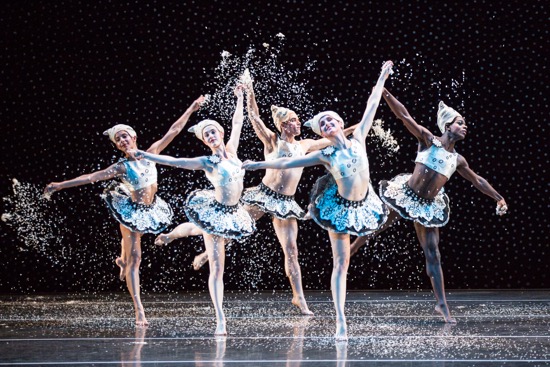
Dancing snowflakes in Mark Morris’s The Hard Nut. (L to R): Elise Drew León, Janelle Barry, Nicholas Wagner, Lesley Garrison, and Brandon Randolph. Photo: Yi-Chun Wu
Mark Morris’s The Hard Nut sets the knowing audience at the Brooklyn Academy laughing in ways that most ballets set to Tchaikovsky’s The Nutcracker do not. But I doubt that ballet aficionados in St Petersburg in 1892 found their eyes moisting up either. This revival of Morris’s music-wise, tradition-flouting version melds human foibles, courage, and generosity in ways that can be outrageously funny but also poignant.
The MMDG Music Ensemble, led by Colin Fowler, plays Tchaikovsky’s overture at a pretty fast clip; at that pace and with certain emphases, it becomes full of excited questioning. What will happen when the curtain goes up? What magic is in the air? The whole production design was based on the work of illustrator and graphic novelist Charles Burns, and such images as a closeup of the mesmerist and toymaker Drosselmeier occasionally loom behind Adrianne Lobel’s black-and-white set, lit by James F. Ingalls. But the friends who gather at the Christmas party hosted by Dr. and Mrs. Stahlbaum in their monochromatic apartment wear astonishing 1970s outfits and wigs in combinations of red and green (the marvelous costumes are by Martin Pakledinaz).
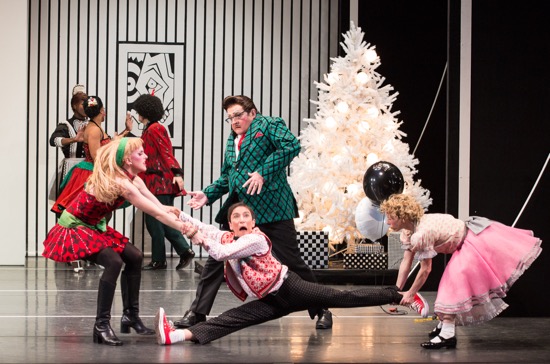
(L to R): Mark Morris’s The Hard Nut, Act 1: Lesle Garrison (Louise), Mark Morris (Dr. Stahlbaum), and Lauren Grant (Marie) restrain June Omura (Fritz). At back: Kraig Patterson, Michelle Yard, and Dallas McMurray. Photo: Yi-Chun Wu
What they imbibe from the red or yellow drinks on the wheeled cart pushed around by the family’s adorably eccentric maid goes to their heads rather quickly. To the music that usually accompanies a stately dance in other Nutcracker productions, Morris finds the beats that correspond perfectly to an emphatic swing of the guests’ hips, and they indulge in it with gusto. Mrs. Stahlbaum (John Heginbotham), who has popped a pill as well as draining several glasses, trips over the exiting drink wagon and ends on the floor with her green skirt in a tangle. Fritz (June Omura) the endlessly naughty son of the family, races around causing trouble, and Louise (Lesley Garrison), the elder sister of innocent little Marie (Lauren Grant, performing her twentieth Hard Nut), is so undone by her raging adolescent hormones that she will hump the leg of any guest unwise enough to pass out.
If you look around the stage, you can spot all manner of telling details: the guests who wish perhaps they were elsewhere; the good natured fellow who hoists Fritz in the air over and over (a reference to George Balanchine’s The Nutcracker, on view at Lincoln Center); the two invitees who present the lady of the house with tiny, identical gift boxes, the louche guy with a sizeable afro (Domingo Estrada, Jr.) pretending to be cool, when he’s really out of it. Dr. Stahlbaum (Mark Morris) is not really in control, although he’s good at leading the guests in carol singing (they open their mouths silently and extravagantly, while the orchestra plays on). Choreographer and ex-Morris company member Heginbotham plays his wife with winning eagerness to please; she can’t control her children, or much of anything. And throughout the first act, Grant makes us feel Marie’s delights and confusions and disappointments. One of the most moving few seconds comes when, during a sort-of reel, she marches downstage hand-in-hand with her parents; never has she been so happy, never has she looked so small.
Former MMDG members like Heginbotham mingle with the present company of seventeen (and the gifted, versatile MMDG dancers may play as many as three roles).The maid—so devious, so flirty, and, yes, so mildly resentful—is played by the man who created the character back in 1991: Kraig Patterson. Scampering about in black pointe shoes and wearing a white-aproned black uniform that looks de rigeur from the front, but bares her/his back from the waist up, Patterson is as sly with his hips as he is whole-hearted with his grin or his disapproving scowl. Omura, who danced in the MMDG for years, beginning in the 1980s, and is now a mother of three, gives a remarkable performance (virtuosic nastiness) as the rampaging, pushy Stahlbaum son. As Fritz, she grabs the remote and causes mayhem with the robot (Durell R. Comedy), who, along with a Barbie doll (Stacy Martorana), has been brought in, gift-wrapped and caused to dance by Drosselmeier. (The rotten kid also breaks another of Drosselmeier’s gifts, a wooden soldier-nutcracker.) Shawn Gannon returns to play one of the guests, and in Act II, a dentist. At least one other dancer not in the company has appeared in previous New York performances. Beginning in 1993, Utafumi Takemura danced as a snowflake and as a rampaging rat; this time she has moved up the rat ranks, playing the three-headed Rat King, as well as the Act II Rat Queen.
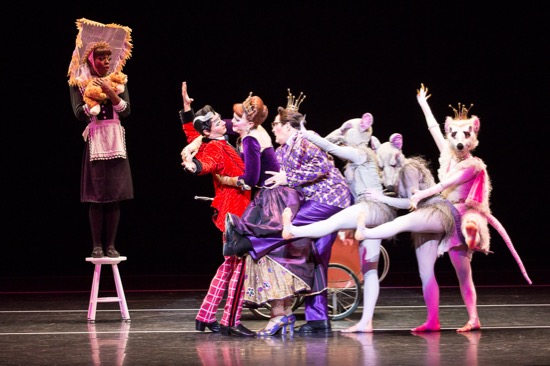
A collision in the story of Princess Pirlipat.(L to R): Brandon Randolph (standing in for Kraig Patterson at the photo call), Billy Smith, John Heginbotham, Mark Morris, Elise Drew, Wendy Reinert, and Utafumi Takamura. Photo: Yi-Chun Wu
MMDG’s Billy Smith assumes the demanding role of Drosselmeier and does extremely well in it. Rob Besserer, the original Drosselmeier and a hard act to follow, was a little subtler in his approach, but Smith makes his own mark on the role—a vital one in terms of how the story develops. It is he who visits Marie, ill with a fever after her hard night’s dream in which the Christmas tree grew, the Nutcracker came to life, and, by throwing her slipper, she helped defeat the rats who—despite their habit of holding up their claws like ladies waiting for their nail polish to dry—were already gnawing on the small army of muscular but dopey G.I. Joe dolls. Drosselmeier is the one who tells Marie the story that comes to life in Act II about the infant Princess Pirlipat, whom the revengeful Rat Queen disfigures, and it is he who goes searching for the golden nut that may restore her beauty and provide her with a champion (someone who can crack the nut with his teeth).
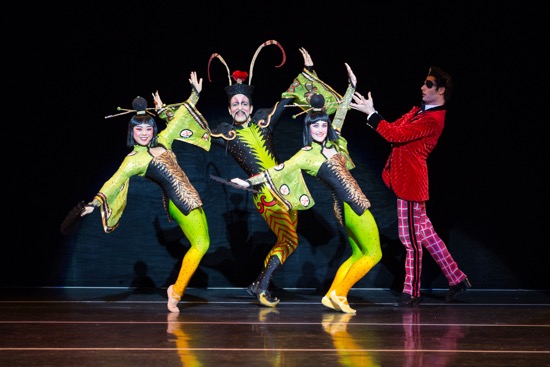
(L to R): Kara Chan, John Eirich, and Janelle Barry, with Billy Smith as Drosselmeier (taken aback) in The Hard Nut‘s Chinese dance. Photo: Yi-Chun Wu
There are many ways in which Morris makes us understand the music and the interwoven stories. In most Nutcrackers, the plot is over in Act I, and Marie and the Nutcracker (now Drosselmeier’s nephew) are entertained in the Land of the Sweets by various native dancers. Instead, Morris’s Drosselmeier encounters dancing denizens of Spain, Arabia, China, Russia, and France as he searches for the badly needed nut, guided by a backdrop map with cities that light up. No bullfighter nor masked Bedouin nor perky Chinese person nor any of the Russians costumed in vivid tents of rags nor one of the Parisians bearing hatboxes and baguettes and strutting on black pointe shoes knows anything about a golden nut, and some have danced offstage before he can even question them. (He gives up and goes home; then the nut descends from above).
Throughout The Hard Nut, Morris neutralizes gender and not just in the major roles of Mrs. Stahlbaum and the maid (who is also Pirlipat’s hapless nurse). Men and women are dressed identically as snow spirits and waltzing flowers. The snow scene that ends Act I is a brilliant piece of choreography for a rushing, leaping ensemble of twenty-two, who appear in squads and lines and circles, tossing handfuls of “snow” to create flurries timed with Tchaikovsky’s music. The flowers dance (and backward half-somersault, showing their panties) in front of a backdrop showing a single phallic calla lily. Heginbotham’s rapturous presence at the center of the scene suggests that his character (he’s also the Queen in the story of the nut and its powers) is having her own kind of spring awakening.
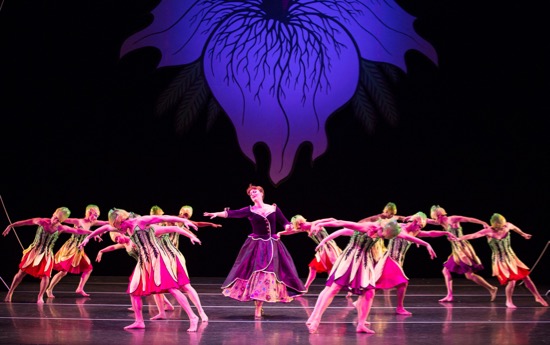
John Heginbotham waltzing with the flowers in Mark Morris’s The Hard Nut. Photo: Yi-Chun Wu
Morris’s musicality and his feelings about the tale attached to it find a beautiful companionship in what would normally be the pas de deux for the Sugar Plum Fairy and a previously unseen Cavalier. To this melodious, gradually soaring music, Morris brings the ardent young Drosselmeier and ex-Nutcracker (Aaron Loux) together with shyly maturing Marie, but they are not alone. Squads of characters from all the previous ensembles run in and out to lift each of the two in turn. Rats and flowers and snowflakes dance in unison throngs, along with representatives of the cultures visited, the costumed men who moved the furniture and changed some of the performers’ costumes on stage, and Marie’s brother and sister. You see these hard-dancing people as fostering this courtship, assembling everyone who brought us to this fairytale moment.
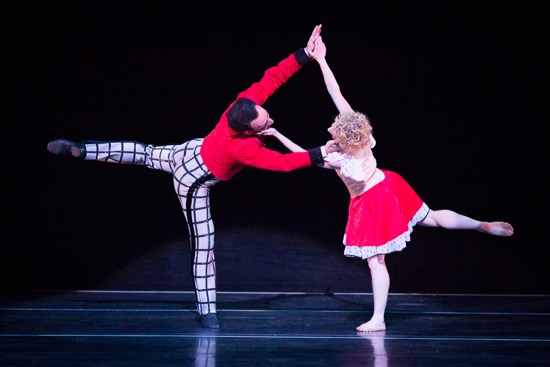
Aaron Loux and Lauren Grant dance together in the final scene of Mark Morris’s The Hard Nut. Photo: Yi-Chun Wu
The duet that develops within the rising flurry and after the group has formally presented Loux to Grant is not your usual pas de deux. He does not lift her or support her. They are to be equal in this partnership. To the lilting music that usually accompanies the Sugar Plum Fairy’s Act II solo, they duplicate several serene, guiding embraces—one person’s front pressed against the other’s back and held there by a protective arm—with which Drosselmeier in an earlier duet seemed to be instructing his young relative. The duet for these two splendid dancers isn’t fancy; it’s keyed to Marie’s innocence and goodness. He dances for her and she for him; they find equanimity in the same springy steps. As they rush together and apart, they seem to grow into new roles. He tries to kiss her, but she, surprised, draws back. He kisses her hand a few times as she retreats. But suddenly, after a few-seconds disappearance from the stage, she’s ready for kissing, and they can’t get enough of it. They’re alone at the end of the piece, walking together toward the unknown future that the back of the stage so often represents.
